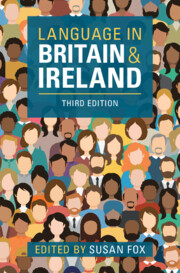Book contents
- Language in Britain and Ireland
- Language in Britain and Ireland
- Copyright page
- Contents
- Figures
- Tables
- Contributors
- Acknowledgements
- Map of Britain and Ireland
- Introduction
- Part I English
- 1 The History of English
- 2 Standard and Non-standard English
- 3 Phonetic and Phonological Variation in England
- 4 Grammatical Variation in England
- 5 Discourse-Pragmatic Variation in England
- 6 Scots and Scottish Standard English
- 7 English in Ireland
- 8 English in Wales
- 9 Insular Varieties of English in Britain
- 9 Insular Varieties of English in Britain
- 9 Insular Varieties of English in Britain
- 9 Insular Varieties of English in Britain
- Part II Multilingualism in Britain and Ireland: The Celtic Languages
- Part III Multilingualism in Britain and Ireland: Minority Languages
- Part IV Multilingualism: The Development of Urban Contact Varieties
- Part V Applied Sociolinguistic Issues
- Index
- References
4 - Grammatical Variation in England
from Part I - English
Published online by Cambridge University Press: 17 October 2024
- Language in Britain and Ireland
- Language in Britain and Ireland
- Copyright page
- Contents
- Figures
- Tables
- Contributors
- Acknowledgements
- Map of Britain and Ireland
- Introduction
- Part I English
- 1 The History of English
- 2 Standard and Non-standard English
- 3 Phonetic and Phonological Variation in England
- 4 Grammatical Variation in England
- 5 Discourse-Pragmatic Variation in England
- 6 Scots and Scottish Standard English
- 7 English in Ireland
- 8 English in Wales
- 9 Insular Varieties of English in Britain
- 9 Insular Varieties of English in Britain
- 9 Insular Varieties of English in Britain
- 9 Insular Varieties of English in Britain
- Part II Multilingualism in Britain and Ireland: The Celtic Languages
- Part III Multilingualism in Britain and Ireland: Minority Languages
- Part IV Multilingualism: The Development of Urban Contact Varieties
- Part V Applied Sociolinguistic Issues
- Index
- References
Summary
This chapter presents an up-to-date overview of what we know about contemporary grammatical variation in England, drawing on a range of sources such as traditional and variationist dialectological investigations, as well as those using new technologies such as smartphone apps and Twitter feeds. It begins with an assessment of how common the use of non-standard morphosyntax is vis à vis Standard English, before presenting a well-cited list of the most widespread features that are claimed to be found right across the country. The chapter then describes contemporary non-standard grammatical variation in England, examining, in turn: verbs, negation, adverbs, prepositions, plural marking, pronouns, comparison forms, articles and conjunctions. Beyond an account of contemporary morphosyntactic variability, this survey also helps us to locate those linguistic features and those geographical areas about which we hold very little up-to-date information, and, in the light of reports of widespread traditional dialect levelling, points to those non-standard features whose vitality appears to be precarious.
Keywords
- Type
- Chapter
- Information
- Language in Britain and Ireland , pp. 98 - 127Publisher: Cambridge University PressPrint publication year: 2024

